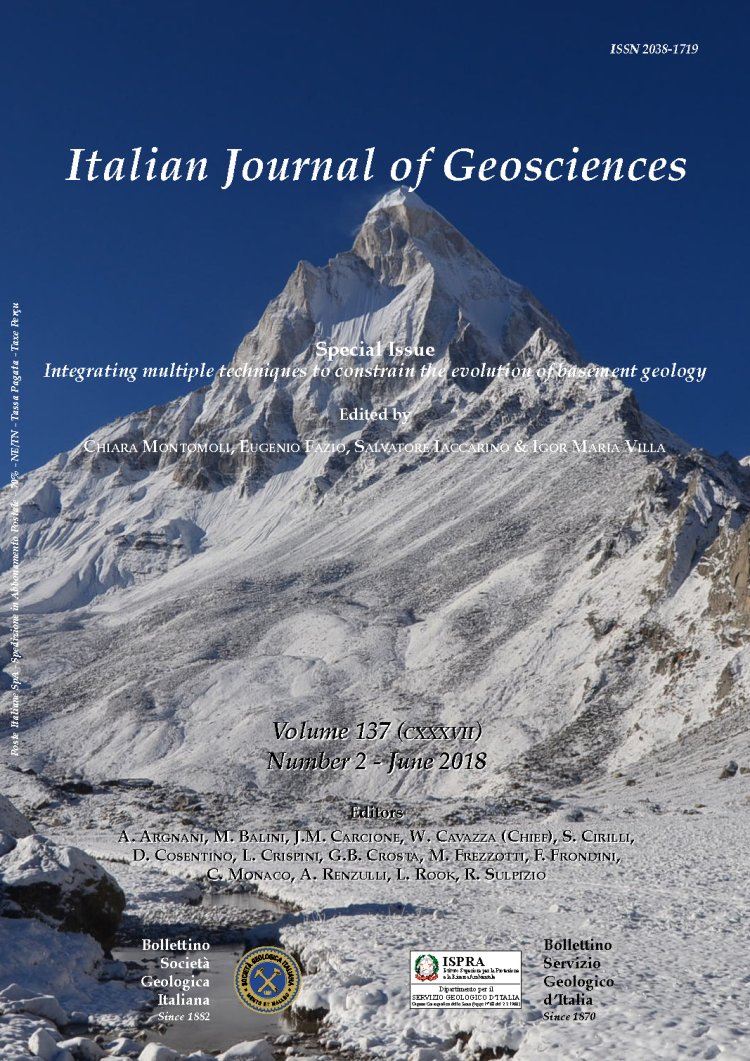
Structural and metamorphic evolution during tectonic mixing: is the Rocca Canavese Thrust Sheet (Italian Western Alps) a subduction-related mélange?
Manuel Roda (1), Francesca De Salvo (1), Michele Zucali (1) & Maria Iole Spalla (1)
(1) Università degli Studi di Milano, Dipartimento di Scienze della Terra, Via Mangiagalli 34, 20133 - Milano (Italy).
Corresponding author e-mail: jediroda@gmail.com.
Volume: 137 (2018) f.2
Pages: 311-329
Abstract
In the Sesia-Lanzo Zone (SLZ), the subunit Rocca Canavese Thrust Sheet (RCT) is characterised by a mixture of mantle- and crust-derived lithologies and can be a good candidate to be a former subduction-related mélange of the Austroalpine domain. The unit consists of metapelites, metagranitoids, metabasics, metagabbro and serpentinised lherzolite lenses from metre to hundred-metre size.
According to the literature, PT peak conditions for all lithologies are 0.8-1 GPa at 300-400°C, in lawsonite-blueschist facies conditions recorded during the Alpine subduction. However recent work describes different mineral assemblages for the metamorphic peak, separating rocks with lawsonite from those with jadeite. Therefore, we refined the meso and microstructural analysis of the tectonic slices of RCT and we performed a detailed thermo-barometry of different metamorphic
stages in order to quantify Alpine peak conditions and P-T-d-t paths, and to test whether the RCT represents a subduction-related mélange. We focus on metagabbros, Jd-bearing and Lws-bearing glaucophanites since they have the most suitable chemistry allowing to reconstruct the complex evolution of the mixing. Metagabbros and Jd-bearing glaucophanites experienced a D1a metamorphic stage characterised by a pressure of 1.3-1.8 GPa and temperature of 450-550°C, in eclogite facies condition. Lws-bearing glaucophanites experienced a D1b metamorphic stage at a temperature <470°C and pressure of ca. 1.2-1.5 GPa, in Lws-blueschist facies condition. The two tectono- metamorphic units (TMUs) were coupled together during the exhumation at D2 stage, under Ep-blueschist facies conditions.
Successive evolution occurs at lower pressure, under greenschist facies conditions. D1a peak conditions are compatible with a thermal gradient between a cold and a warm subduction zone while D1b peak is recorded in a thermal gradient compatible with a cold subduction.
The coupling between the two TMUs occurred under a cold thermal gradient, suggesting a still active subduction. The different origin and P-T-d-t paths of the blocks, the intense shearing experienced by all lithologies during their coupling and the abundance of serpentinites in the tectonic mixture agree with the interpretation of a subductionrelated mélange for RCT, in analogy with other zones of the Alps.
Keywords
Alpine subduction, Austroalpine Domain, multiscale petrostructural analysis, Rocca Canavese Thrust Sheet, tectonic mélange.
Get Full Text Supplementary Material